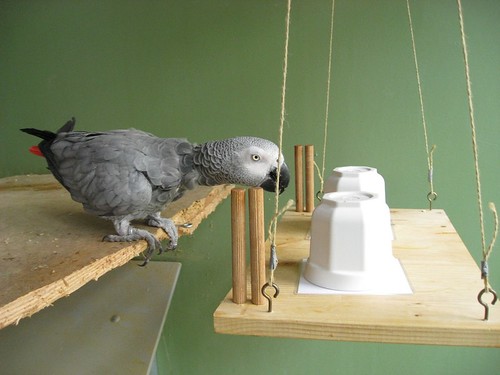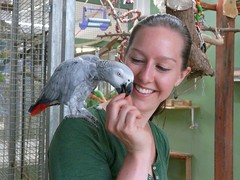 When one parrot, named Awisa, saw two different types of food placed in a cup and later saw a researcher show her one of the types of food, she figured out that the researcher must have removed the food from one of the cups, leaving the other snack undisturbed. About 75 percent of the time, Awisa picked the undisturbed cup as the one that would contain a food treat. Credit: © Sandra Mikolasch
When one parrot, named Awisa, saw two different types of food placed in a cup and later saw a researcher show her one of the types of food, she figured out that the researcher must have removed the food from one of the cups, leaving the other snack undisturbed. About 75 percent of the time, Awisa picked the undisturbed cup as the one that would contain a food treat. Credit: © Sandra Mikolasch
Parrots are capable of logical leaps, according to a new study in which a gray parrot named Awisa used reasoning to figure out where a bit of food was hidden.
The task is one that kids as young as 4 could figure out, but the only other animals that have been shown to use this type of reasoning are great apes. That makes gray parrots the first non-primates to demonstrate such logical smarts, said study researcher Sandra Mikolasch, a doctoral candidate at the University of Vienna.
"We now know that a gray parrot is able to logically exclude a wrong possibility and instead choose the right one in order to get a reward, which is known as 'inference by exclusion,'" Mikolasch wrote in an email to LiveScience.
Are you smarter than a parrot?
Parrots are no birdbrains. One famous gray parrot, Alex, even understood the concept of "zero," something children don't grasp until they are 3 or 4. Alex, who died in 2007, had a vocabulary of 150 words, which he seemed to use in two-way communication with the researchers who worked with him.
Other animals have also revealed high levels of intelligence. Elephants, for example, know when and how to cooperate. And hyenas are even better than primates at cooperation.
Earlier studies had shown that about one out of five chimps and other great apes could use logical reasoning to find hidden food.
To see if some birds could do the same, she and her colleagues trained seven gray parrots to choose between a cup where they'd seen food hidden and a cup without food. Once the parrots learned how to get a treat by choosing the right cup, Mikolasch set up an experiment to test their ability to infer by exclusion.
In one test, she would hide one piece of food (for example, a seed) in one cup and another piece of food (such as a walnut) in another cup while a parrot watched. Next, she'd pick up one cup, show the food to the parrot and re-hide it, or she'd pick up a cup, show the food to the parrot, and put the food in her pocket. The parrot then got to choose a cup. [See pictures of the clever parrots]
 A new study, published June 21 in the journal Royal Society Biological Sciences, finds that parrots can use logical reasoning to find food hidden in one of two cups. CREDIT: © Sandra Mikolasch
A new study, published June 21 in the journal Royal Society Biological Sciences, finds that parrots can use logical reasoning to find food hidden in one of two cups. CREDIT: © Sandra Mikolasch
In a second experiment, Mikolasch did the same thing, but did so behind an opaque screen. The parrot only saw her hold up a piece of food she had removed, but didn't see her remove it. So the parrots, if they're using their smarts, should know that the cup that once held that type of food is now empty. The logical conclusion, then, is that the other cup still has food in it. If the parrots consistently pick the food-filled cup, it suggests they are making that logical inference.
The researchers controlled the experiment to make sure their results weren't the result of the birds smelling the remaining food.
Learning to reason
Three of the seven parrots proved quite good at picking a cup with food in the experiment in which they'd seen the researcher remove or re-hide the snack. These three parrots — Maja, Moritz and Awisa — chose a cup with food at least 70 percent of the time, significantly better than chance. But in the experiment in which the food had been removed behind a screen and shown to the parrot later, only Awisa, a 13-year-old female, figured out where the remaining food was, choosing that cup 76 percent of the time.
 Researcher Sandra Mikolasch, pictured here, says the research is reason to treat animals with respect. She did the experiment at a bird rescue facility, and many of the parrots had endured terrible conditions before being taken in by the facility. CREDIT: © Sandra MikolaschAwisa may have been successful because she's a parrot "whiz kid," similar to the kid in math class who always scores an A-plus, Mikolasch said. It's also possible that the other birds are capable of logical reasoning, but something about the test conditions distracted or confused them.
Researcher Sandra Mikolasch, pictured here, says the research is reason to treat animals with respect. She did the experiment at a bird rescue facility, and many of the parrots had endured terrible conditions before being taken in by the facility. CREDIT: © Sandra MikolaschAwisa may have been successful because she's a parrot "whiz kid," similar to the kid in math class who always scores an A-plus, Mikolasch said. It's also possible that the other birds are capable of logical reasoning, but something about the test conditions distracted or confused them.
The fact that not all the birds figured it out suggests that logical reasoning is no easy task for them, much as four out of five great apes had trouble with the same experiment. In an earlier study, Mikolasch said,18 out of 20 4-year-olds were capable of making the same logical leap as Awisa.
Intriguingly, the researchers found, Awisa got better at guessing the right cup in the experiment where she didn't see the food removed, but not in the experiment in which she did. That suggests that the parrot "learned to reason" about what the researcher was doing behind the screen, Mikolasch wrote.
"I think it is one more step to show the cognitive abilities of birds and animals in general," she said. "More attention should be paid to their needs … As I tested the grey parrots in a parrot rescue center, I know in what bad conditions some of them had to live for several years before they were rescued."
The study is detailed today (June 21) in the journal Biology Letters.